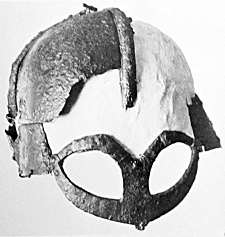A good question, I love it

Thing is that to this day only a single helmet has been excavated which can definitely be linked to the old vikings. Gjermundbu helmet (named after the place where it was excavated):

Other helmets which have been found all date from later times or different people (Angles, Saxons etc.). Not a one of them however had any horns on them. There are quite a few medieval depictions and statues made by the vikings or made by other people depicting the vikings. For all I know not a single one of the medieval depictions shows a viking with a horned helmet. I'm not sure if I missed any, but in case a picture with horned vikings was made for example by a Christian monk (who usually did book illustrations etc.) it would be more likely than not that the horns were to link those "wild savages and plunderers of churches and monasteries" to the devil (but again, I am not aware of a single contemporary or even late medieval depiction of a helmet with horns).
In 19th century all of a sudden such pictures cropped up. The 19th century has done more than any other period of time to mess up our image of the middle ages. There were two main views of the middle ages, neither of which allowed for an objective view. One was to taint the middle ages as nothing more but a "dark age" (I think the term which nowadays is used mostly to the first few centuries after the fall of Rome (and still is a contestable description) was brought up in 19th century for the first time). In this view which was based especially on an extreme pride on the achievements of industrialization the middle ages were depicted as nothing more as an age of dirt, plague, religious fanaticism, and brutal exploitation of the majority by a tiny minority. There are some true elements in this but they largely ignore great achievements of the middle ages, blow certain problems out of proportion, or project problems existing in some areas on the entire world. Also this interpretation of the middle ages "invented" some medieval views in order to demonstrated how stupid people back then had supposedly been by comparison to the illuminated people of the 19th century (the best example for this is the false notion that people in the middle ages believed the earth was flat; a myth which is still believed by many). The other view romanticized the middle ages in which values like chivalry and honor, which were felt to be fading away in the age of industrialization, were extremely prominent. This kind of interpretation can very prominently be found in some Victorian age literature and also in the earlier works by Sir Walter Scott.
Getting back to the horned viking helmet, it was not the only piece of medieval equipment which became popular in the 19th century even though it most likely never existed. Another example for such a 19th century piece of medieval equipment is a flail with a short handle and a spiked metal ball attached to it with a chain. That one is also believed by many to have been medieval equipment, but there is no source or picture from the middle ages depicting or describing such a thing. There were mazes and long handled flails with long heads in the sources, but nothing like the thing I described above.
If one takes a look at the question under the perspective of sensitivity then it would be a very bad idea to have horns attached to your helmet. Granted, they might look intimidating to an opponent, but if said opponent hits the horn with a weapon in an angle that would otherwise just glance off the helmet, it would probably yank the head of the helmet's owner possibly throwing him of balance or even breaking his neck. In most things they did the vikings though very practical and it is rather unlikely that they would take such unnecessary risk and never document it if they did.
It is a lot more difficult to prove that something did NOT happen than proving that something DID happen. We do not have any historical source saying "No viking ever wore horns on his helmet", but we do not have any contemporary source whatsoever to suggest that they ever did.
There is one grain of truth however which may have contributed to the evolving of the myth of the horned viking helmets. There are medieval depictions of horned helmets, but these depictions neither show helmets that can be linked to the vikings nor do they depict helmets which are likely to have ever worn in battle. In tournaments or for special ceremonies there were "show off helmets" which were often loaded with a lot of decoration (including statues, animal heads (hopefully no real, smelly ones

), and long ribbons) which would be all but obstrusive in a real battle.
Here is an image of the seal of Albert of Sweden which includes such a ceremonial helmet.

The seal dates from 14th century though, hundreds of years after the classical viking time and the helmet looks nothing like the clishÈ viking helmet.

 The forum should now be back up and running. Please don't hesitate to let us admins know if you run into any issues.
The forum should now be back up and running. Please don't hesitate to let us admins know if you run into any issues.